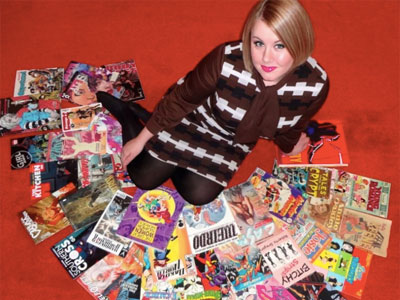Beyond Wonder Woman

Comic book editor, publisher and historian Hope Nicholson presented on “Comic Women/Women in Comics: Creators, Characters, Fans” at Jorgenson Hall on November 15.
On November 15, comic book editor, publisher and historian Hope Nicholson discussed the history of women in comics at an event hosted by the Department of English. Speaking to the audience at Jorgenson Hall, Nicholson said, “I am a woman in comics, and when I first started getting in the industry, I was like, ‘Oh… this sucks.’”
But it’s not quite as simple as that. “This industry is not comfortable for most women,” said Nicholson, Winnipeg-based publisher of Bedside Press (external link) . “But it doesn’t stop women from being in comics, and as far as you go back in the history of comics, there are women there making comics, publishing comics, being fans of comics, and of course being on the pages of comics.
“It’s a misbelief that I’m trying to break that women are new to comics. I often get asked by mainstream press, ‘Why are women into comics now?’ And I’m like, ‘No, no, no… stop talking.’”
The modern comic book emerged in the 1930s, an outgrowth of newspaper comic strips and often-sexist pulp magazines. The decade saw the emergence of a few key female creators: Marge Buell became a powerful figure when she retained ownership and creative control of her wildly popular comic strip character Little Lulu; Jackie Ormes, an African American cartoonist, created the successful Torchy Brown strip.
Though there were a handful of female creators in the ’30s, ’40s, and ’50s (including Tarple Mills, Doris Slater and others), mainstream comics typically consigned female characters to supporting (Lois Lane), sinister (as in the popular EC horror comics), or stereotypical “dumb blonde” roles. Though female superheroes existed (Wonder Woman, Black Cat), and romance comics enjoyed strong female followings in the ’50s, women rarely wrote these. Even so, female artists existed in these years, and women found some significant roles in management (notably Jenette Khan, who became publisher of DC Comics).
In the 1960s, “you started to see more women in comics behind the scenes, in terms of editing. In terms of creatorship, there was less.” However, “often the roles of colorists were given to wives, girlfriends, sisters, whatever. ‘No one wants to do this work, and we don’t pay much for it, so you can do it.’ But for a long time, women dominated in the colorist field in comics.”
Unsurprisingly, female creators began to tell their stories through an alternative route, publishing as part of the Underground Comix movement of the 1970s. Comic sales among women decreased in the 1980s (a fact Nicholson attributes partly to the rise of the sometimes-toxic comic book stores), but that decade also saw the emergence of important creators like Alison Bechdel.
Described by Nicholson as “the dark days,” the ’90s saw an increase in highly sexualized depictions of female characters, but also saw the birth of web comics. This new form exploded in the 2000s, giving rise to popular artists like Kate Beaton and Gisèle Lagacé. The 2000s also saw high-profile graphic novels like Marjane Satrapi’s Persepolis and Phoebe Gloeckner’s The Diary of a Teenage Girl.
“Superhero comics have always been more closed off to female creators, but we have seen that even since the beginning they were present,” said Nicholson. “[With] web comics, all you needed was an internet connection and a scanner and some Photoshop software and you could put a comic online, and you could keep putting it online.”
Today, female readership of comics is close to par with male readership, and Kickstarter has provided a new funding source for independent work. Throughout the decades, women have never stopped being part of fan communities, appearing on the letters pages, at conventions, and at cosplay events. But while there are more female artists/writers at major comic companies than ever before, the numbers are still unfortunate: women rarely headline the big-budget comic book movies, and Marvel Comics only recently hired its first-ever black female writer (external link) .
“There are definitely improvements from the 1940s,” said Nicholson. “Things like sexuality and race are becoming more important, and things like gender representation. We’re seeing a lot more focus on increasing transgender representation in comics … and I just hope we can keep that up and nothing horrible happens to America that changes and makes us slide backwar